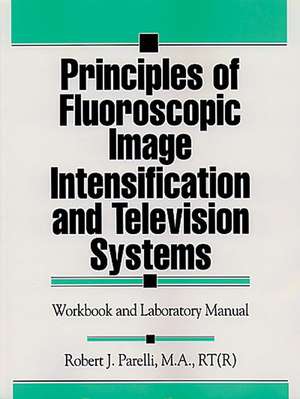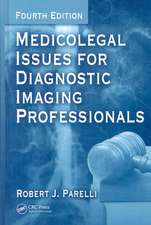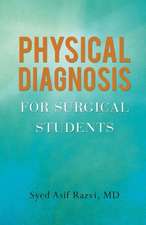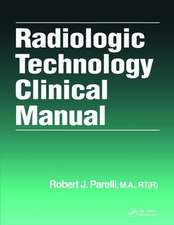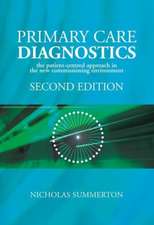Principles of Fluoroscopic Image Intensification and Television Systems: Workbook and Laboratory Manual
Autor Robert J. Parellien Limba Engleză Paperback – 21 noi 1996
Toate formatele și edițiile
| Toate formatele și edițiile | Preț | Express |
|---|---|---|
| Paperback (1) | 540.14 lei 6-8 săpt. | |
| Taylor & Francis – 21 noi 1996 | 540.14 lei 6-8 săpt. | |
| Hardback (1) | 1090.18 lei 6-8 săpt. | |
| Taylor & Francis – 18 dec 2020 | 1090.18 lei 6-8 săpt. |
Preț: 540.14 lei
Preț vechi: 652.41 lei
-17% Nou
Puncte Express: 810
Preț estimativ în valută:
103.35€ • 107.91$ • 85.54£
103.35€ • 107.91$ • 85.54£
Carte tipărită la comandă
Livrare economică 04-18 aprilie
Preluare comenzi: 021 569.72.76
Specificații
ISBN-13: 9781574440829
ISBN-10: 1574440829
Pagini: 252
Dimensiuni: 210 x 280 x 15 mm
Greutate: 0.63 kg
Ediția:1
Editura: Taylor & Francis
Colecția CRC Press
Locul publicării:Oxford, United Kingdom
ISBN-10: 1574440829
Pagini: 252
Dimensiuni: 210 x 280 x 15 mm
Greutate: 0.63 kg
Ediția:1
Editura: Taylor & Francis
Colecția CRC Press
Locul publicării:Oxford, United Kingdom
Public țintă
ProfessionalCuprins
Preface -- Author -- Chapter 1: Image Intensifier System -- Image Intensifier Tube Design -- Input Phosphor and Photocathode -- Electrostatic Focusing Lens -- Accelerating Anode -- Output Phosphor -- Dual Field Image Intensifier Tubes -- Conversion Factor and Gain -- Flux Gain -- Minification Gain -- Image Quality -- Automatic Brightness Stabilization -- Review Questions -- Chapter 2: Objective and Camera Lenses -- Optics -- Real and Virtual Images -- Review Questions -- Chapter 3: Closed Circuit Television Systems -- Camera Pick-Up Tubes -- Video Signal -- Television Scanning System -- Camera Control Unit -- Synchronization -- Television Monitor -- Television Image Quality -- Plumbicon and Image-Orthicon Cameras -- Review Questions -- Chapter 4: Recording the Television Image -- Magnetic Recorders -- Video Tape Recorders -- Cinefluororadiography -- Spot-Film Camera System -- Film /Screen Spot-Film Device -- Equipment Requirements -- Review Questions -- Chapter 5: Computerized Fluoroscopic Image Intensification -- Computerized Fluoroscopy -- Mask Mode Image Intensification -- Time Interval Difference (TID) Mode -- K-Edge Image Intensification -- Combination vs. Unmixed Digital Techniques -- X-ray Exposure with Computerized Image -- Intensification -- The Future of Computerized Image Intensification. -- Review Questions -- Chapter 6: Fluoroscopic Image Production -- Electromagnetic Radiation -- Production of X-radiation -- X-ray Interaction with Matter -- Review Questions -- Chapter 7: Factors Affecting Patient and Operator Exposure -- Review Questions -- Chapter 8: Health Effects of Low Level X-ray Exposure -- Somatic Dose Indicators -- Genetic Dose Indicators -- Genetically Significant Dose -- Review Questions -- Chapter 9: Biological Effects and Significance of X-ray Exposure -- Cellular Amplification -- Gross Cellular Effects of Radiation -- Latent Period -- Dose Effect Curves -- Radiosensitivity of the Cell -- Short-Term Effects -- Long-Term Effects -- Review Questions -- Chapter 10: Personnel Radiation Protection -- ALARA -- Operator Protection during Image Intensification Procedures -- Other Protective Devices and Accessories -- Review Questions -- Chapter 11: Personnel Monitoring -- Film Badge -- Thermoluminescent Dosimeter (TLD) -- Pocket Ionization Chambers -- Maximum Permissible Dose (MPD) -- Occupational and General Dose Equivalent Limits -- Frequency of Exposure Recording -- Overexposure of a Personnel Monitoring Device -- Cumulative Occupational Dose Equivalent -- Location of Personnel Monitoring Device -- Who Must Be Monitored -- Review Questions -- Chapter 12: Pediatric Fluoroscopy -- Motion -- Personnel and Parental Protection -- Gonadal Shielding -- Automatic Exposure Control (AEC) -- Other Technical Considerations -- Review Questions -- Chapter 13: Mobile Image Intensification Equipment -- Structural Provisions -- Equipment Provisions (Mobile C-Arm) -- Boost Position (High-Level Control Button) -- Mobile Fluoroscope Quality Control -- Review Questions -- Chapter 14: California Radiation Control Regulations— -- Responsibility of the Supervisor and Operator -- Restrictions -- Display of Documents -- Record Keeping Requirements -- Incident Notification Requirements -- Required Training and Information Provided to X-ray Users -- X-ray Equipment Safety Provisions -- Supervision of Radiologic Technology Personnel -- Technologists’ Fluoroscopy Clinical Instruction -- Reduction in Dose -- Scheduling Radiologic Examinations for Women of Child-Bearing Years -- Therapeutic Abortions -- Occupationally Exposed Women of Procreative Age -- Summary of Gonad Shielding in Diagnostic Radiology -- Visual Physiology -- Half Value Layer (HVL) -- Review Questions -- Chapter 15: Three-Dimensional Fluorographic Anatomy -- Fluoroscopic Localization Techniques -- Gallbladder Fluoroscopy -- Terminal Ileum Fluoroscopy -- Knee Arthrography -- Review Questions -- Chapter 16: Fluoroscopy Quality Assurance and Quality Control Program -- Principles of a Quality Assurance Program -- Quality Assurance Program for Fluoroscopic -- Systems and Associated Equipment -- Acceptance Testing -- Establishment of ALARA -- Fluoroscopy Equipment Quality Control Tests and Frequency -- Review Questions -- Appendix A: Answers to Review Questions -- Appendix B: Statement of Competency -- Appendix C: Review Test /Answers -- Appendix D: Laboratory Experiments -- Lab # 1: Scatter Radiation -- Lab #2: Source-to-Table-Top Distance -- Lab #3: Grid Alignment -- Lab #4: Fluoroscopic Resolution Test -- Lab #5: Maximum Fluoroscopic Exposure Rate -- Lab #6: Fluoroscopy Low Contrast Performance -- Lab #7: Automatic Exposure Control Evaluation for Film Recording System /Reproducibility -- Appendix E: Glossary -- Appendix F: Bibliography -- Index.
Recenzii
". . . written primarily for students enrolled in radiography training programs. . . appealing because few radiographic textbooks provide a . . . discussion of the cameras and closed-circuit television systems used in fluoroscopic imaging."
-Radiology
Review:
"I highly recommend this book for use by any student or professional seeking to improve their understanding."
Beth Graff, Imaging Specialist, Arnold Palmer Hospital for Women & Children, Orlando, Florida
-Radiology
Review:
"I highly recommend this book for use by any student or professional seeking to improve their understanding."
Beth Graff, Imaging Specialist, Arnold Palmer Hospital for Women & Children, Orlando, Florida
Descriere
This unique workbook can be used as a stand-alone text or supplemental text for any course designed to enhance the work of radiologic technology students
